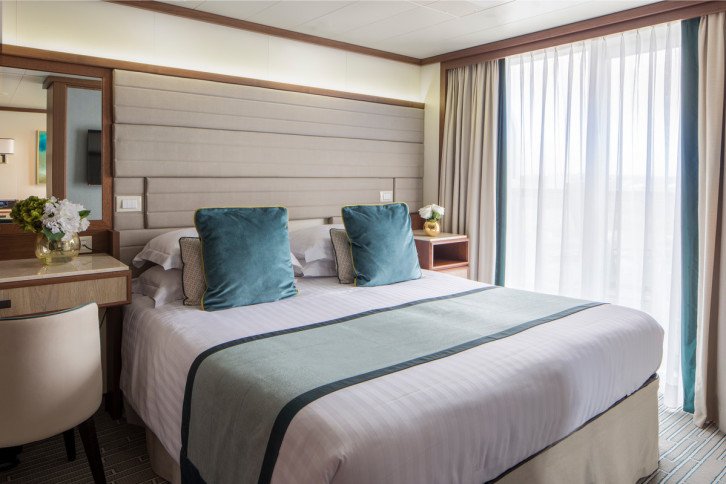(Prices correct as of today’s date, are updated daily, are subject to change and represent genuine availability at time of update).
This cruise only holiday is financially protected by ABTA
Please click here to check the essential travel requirements before booking this cruise.
Want to add a hotel stay or change your flights?
Just call our team of cruise specialists to help build your dream cruise holiday today!
Prices based on 2 people sharing. Cruise only price does not include flights. Fly-cruise price may vary by chosen UK airport.
Itinerary
Southampton
Lying near the head of Southampton Water, a peninsula between the estuaries of the Rivers Test and Itchen, Southampton is Britain’s largest cruise port. It has been one of England’s major ports since the Middle Ages, when it exported wool and hides from the hinterland and imported wine fro... Read More
Southampton
At Sea
At Sea
Cádiz
At Sea
Palma de Mallorca
At Sea
Cagliari
At Sea
Ibiza
Cartagena
Gibraltar
At Sea
At Sea
Southampton
What's Included with
P&O Cruises
Accommodation
Breakfast, lunch, dinner and snacks in a choice of included dining venues
Entertainment throughout the day and evening
Use of swimming pools, hot tubs, fitness centre and leisure facilities where available
Complimentary shuttle service from ship to port where available
Port taxes
Themed events and discos
Tea and coffee in seleted venues
Porterage of luggage from port to cabin
Youth programmes for 2-17 year olds
Free of charge babysitting from 6 months - 4 years of age. Daily from 6pm to 2am
Explore Britannia
Market Cafe
Settle into a cosy world of temptation at the Market Café. With a fresh menu created by master pâtissier and P&O Cruises Food Hero Eric Lanlard, this luxurious haven in the heart of Britannia’s atrium offers something sweet for every palate.
The Blue Bar
Elegant. Sophisticated. Refined.The Blue Bar will find guests cosseted in the ship’s very heart with a view of Britannia’s stunning starburst sculpture and a cocktail list in hand. What could be better?
Sports Court
Whether you enjoy the friendly competition of an organised tournament or prefer to play casually with your own party, short tennis, football, volleyball, basketball and cricket are just some of the options available in the Sports Court. And just aft of the Sports Court you will find the golf nets, where you can perfect your swing, using your own clubs or those provided.
The Reef
The Reef children’s club caters for all ages, combining fun with education and a whole host of activities organized daily by qualified Reef Rangers. Split into four age groups, children of all ages are entertained safely throughout the day and evening and to ensure that they have the chance to make friends of their own age.
- Splashers’ for 2 – 4 year olds
- ‘Surfers’ for 5 – 8 year olds
- ‘Scubas’ for 9 – 12 year olds
- ‘h2o’ for 13 – 17 year olds
Sports Deck

- Sunbathing Arena
- Bar
- Golf Nets
Sun Deck

- The Retreat
- Whirlpool Spa
- Serenity Pool & Bar
- Deck Games
- Children's Play Area
- Surfers (The Reef)
- Aerobics Studio
- Gymnasium
- Splashers (The Reef)
- (Night) Nursery Under 2's
- Scubas (The Reef)
- H2O (The Reef)
- The Cookery Club
- Terrace Pool
Lido Deck

- Single Inside Cabins with Shower
- Single Inside Balcony Cabins with Shower
- The Crow's Nest
- The Marlow Suite
- Library
- Ivory Suite
- Fine Dining Restaurant
- The Pizzeria
- Lido Bar
- Lido Grill
- Lido Pool
- Riviera Pool
- Ice Cream Grab & Go
- Riviera Bar
- Horizon Restaurant
- Beach House
- Sunset Bar
Deck A

- Inside Cabins with Shower
- Larger Inside Cabins with Shower
- Balcony Cabins with Shower
- Balcony Cabins with Shower and Sofa
- Superior Deluxe Balcony with Bath/Shower
- Suite with Bath/Shower
- Launderette
Deck B

- Inside Cabins with Shower
- Larger Inside Cabins with Shower
- Balcony Cabins with Shower
- Balcony Cabins with Shower and Sofa
- Superior Deluxe Balcony with Bath/Shower
- Suite with Bath/Shower
- Launderette
Deck C

- Inside Cabins with Shower
- Larger Inside Cabins with Shower
- Balcony Cabins with Shower
- Balcony Cabins with Shower and Sofa
- Suite with Bath/Shower
- Launderette
Deck E

- Inside Cabin with Shower
- Balcony Cabin with Shower and Sofa
- Balcony With Shower (Without Sofa)
- Suite with Bath/Shower
- Launderette
Deck F

- Inside Cabin with Shower
- Balcony Cabin with Shower and Sofa
- Suite with Bath/Shower
- Launderette
Deck D

- Inside Cabin with Shower
- Balcony Cabins
- Suite with Bath/Shower
- Launderette
Deck G

- Inside Cabins with Shower
- Balcony Cabins with Shower and Sofa
- Suite with Bath/Shower
- Launderette
Main Deck

- Headliners Theatre
- The Crystal Room
- The Glass House
- Java
- Future Cruise Sales/Loyalty
- Photo Gallery
- The Studio
- Sindhu
- The Live Lounge & Bar
Tween Deck

- Headliners Theatre
- Brodie's Bar
- Casino
- Shopping
- Peninsular Restaurant
- Oriental Restaurant
Landing Deck

- Oasis Spa
- Hydrotherapy Suite
- Salon
- Treatment Rooms
- Explorers
- Reception
- The Limelight Club
- Shopping
- Atrium
- Market Cafe
- Blue Bar
- Meridian Restaurant
Britannia Cabins & Suites


Inside Cabins



Super Deluxe Balcony Cabins







-large_thumb.jpg)









